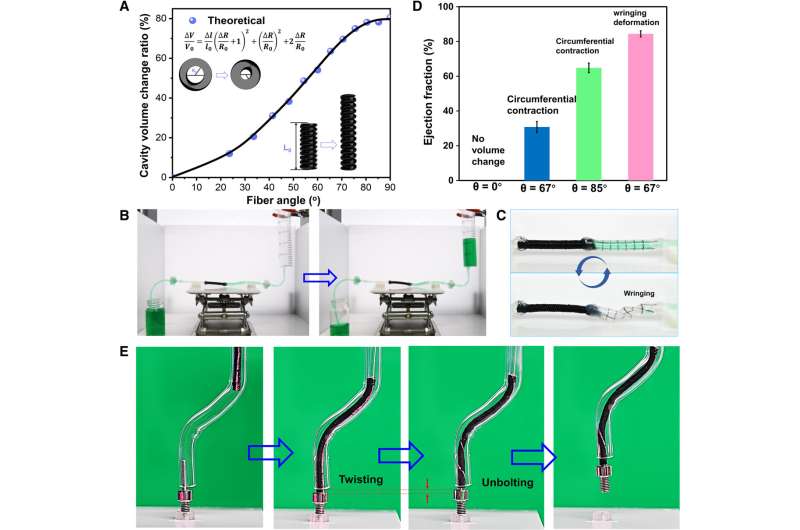June 27, 2023 report
This article has been reviewed according to Science X's editorial process and policies. Editors have highlighted the following attributes while ensuring the content's credibility:
fact-checked
peer-reviewed publication
trusted source
proofread
Engineering liquid crystal elastomers inspired by elephant trunks to make artificial plants

Engineers at Westlake University, China, have created a synthetic tube of liquid crystal elastomers with a unique range of motion. In their paper, "Bioinspired helical-artificial fibrous muscle structured tubular soft actuators," published in Science Advances, the engineering team reveals the unique manufacturing technique used to achieve a remarkably versatile tubular structure.
Creating tubular soft actuators with controllable and programmable shape transformations is highly desired for scientific and engineering applications. Current synthetic tubular actuators using soft active materials have limited contraction and expansion deformations and heavily restricted degrees of freedom, hindering their potential uses.
The researchers leverage liquid crystal elastomers (LCEs), a type of smart active material, to develop tubular soft actuators. LCEs can undergo large-scale reversible deformations and can be encoded with "morphing instructions." This enables the creation of compact, programmable, small-scale morphing devices with wide-ranging potential engineering applications.
For inspiration, the researchers investigated the most impressive tubular soft actuator in nature, the elephant's trunk. Without bones and joints, the long trunk of an elephant can still operate a wide range of complex tasks, from breathing and trumpeting to drinking and showering, grabbing objects, lifting and manipulating them, and articulating with unparalleled degrees of freedom.
Elephant trunk muscle fibers are multi-layered, directionally arranged and wound around the trunk's long axis to form the tubular structure. Assignment of specific alignments allows the trunk to take on diverse morphing modes including single-deformation modes, such as shortening, elongation, bending, and torsion, but also compound morphing modes that combine two or more deformations.
Based on the trunk musculature, the researchers developed a fabrication platform for filament winding to construct helical-artificial fibrous muscle-structured tubular soft actuators (HAFMS-TSAs). With these directional arrangements, they could replicate the natural concept and achieve programmable deformations in the HAFMS-TSAs. The researchers also discovered critical winding angles that enable the decoupling and coupling of different types of deformations, further expanding the range of achievable morphing behaviors.
The researchers then applied HAFMS-TSAs to the creation of an artificial plant capable of displaying all three categories of photoresponse movements observed in real plants: phototropic movements (orienting toward the light), photophobic movements (orienting away from the light), and photonastic movements (morphing and orienting upon light irradiation, regardless of light direction).
Further borrowing from observations in nature, the artificial plant was designed with photoresponsive organs, stems, branches and leaves with specific photoresponses. The lower stem remained photophobic, maintaining support for the upper phototropic structures bending towards the light. When the light intensity exceeds a given threshold, the branches and leaves turn away from the light through a built-in feedback loop that provides an effective self-protection mechanism.
Adaptive and autonomous tubular morphing structures that respond to varying radiation environments could have applications in solar energy collection, solar sails for space stations, probes or satellites, self-regulating optical devices, thermo-regulating buildings or as a house plant that never needs watering and can occasionally hand you a peanut.
More information: Zhiming Hu et al, Bioinspired helical-artificial fibrous muscle structured tubular soft actuators, Science Advances (2023). DOI: 10.1126/sciadv.adh3350
© 2023 Science X Network


















